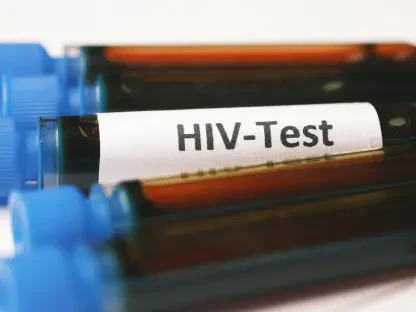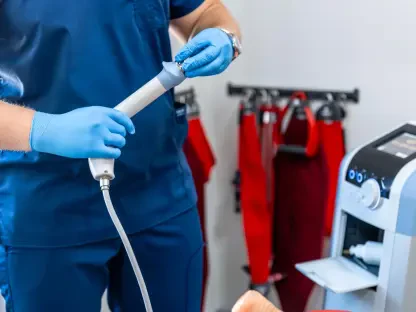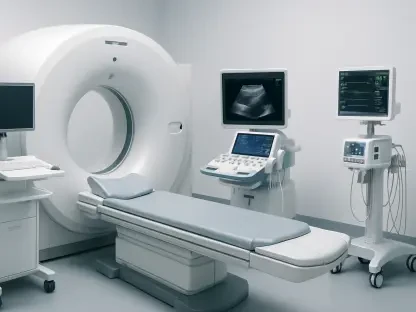Imagine a world where millions of people struggle daily with a condition as common yet complex as functional constipation (FC), a gastrointestinal disorder that impacts roughly 10-15% of the global population with chronic symptoms like infrequent bowel movements and straining. This condition not only diminishes quality of life but also places a significant strain on healthcare systems due to the challenges in diagnosis and management. Accurate identification of FC subtypes—normal transit constipation (NTC), slow transit constipation (STC), defecatory disorders (DD), and mixed forms—is crucial for tailoring effective treatments. For years, traditional methods like radiological testing with radiopaque markers have been the go-to approach for assessing colon transit, despite drawbacks such as radiation exposure and a lack of physiological relevance. Now, a promising alternative, Tc-99m scintigraphy, emerges as a potential game-changer. This nuclear medicine technique, using a radionuclide-labeled meal, offers a more natural glimpse into gut motility. Could this method redefine how clinicians approach colon transit testing? The following exploration delves into its capabilities, benefits, and the hurdles yet to overcome, shedding light on a possible shift in diagnostic paradigms.
Advancements in Diagnostic Approaches
Feasibility of Tc-99m Scintigraphy
One of the most striking revelations about Tc-99m scintigraphy is its ability to effectively visualize colon transit in patients with functional constipation for up to 48 hours, despite the isotope’s notably short half-life of just six hours. Historically, this brief duration raised concerns about its suitability for prolonged imaging, as it was assumed that the radionuclide would decay too quickly to capture meaningful data over extended periods. However, in cases of constipation, the natural accumulation and slower movement of stool through the colon appear to counteract this limitation, allowing the isotope to remain detectable for longer than expected. A pivotal study conducted at Beijing Tsinghua Changgung Hospital with 47 FC patients demonstrated this unexpected efficacy, showing that Tc-99m scintigraphy could consistently track transit patterns during critical time frames. This finding challenges long-held assumptions and suggests that the method could be more versatile than previously thought, opening doors to broader clinical applications in regions where alternative isotopes are unavailable.
Beyond the technical success of imaging duration, the practical implementation of Tc-99m scintigraphy offers a glimpse into how diagnostic tools can adapt to real-world constraints. In the study, patients ingested a solid meal labeled with Tc-99m-DTPA, composed of everyday items like egg white and bread, which mimics natural food transit far better than artificial markers. Images captured at multiple intervals using a gamma scintillation camera provided detailed insights into gut motility without the need for repeated radiation-heavy procedures. This physiological approach not only aligns more closely with actual digestive processes but also highlights the method’s potential to fit into diverse healthcare settings. As nuclear medicine infrastructure continues to expand globally, the feasibility of this single-isotope technique could make it a cornerstone for assessing colon transit, particularly in areas limited by resource availability.
Comparison with Traditional Methods
When placed side by side with the traditional radiological method using radiopaque markers, Tc-99m scintigraphy shows remarkable promise in terms of diagnostic reliability. The radiological approach, long considered the standard, involves patients ingesting markers and undergoing X-rays to track their movement, often exposing them to cumulative radiation over multiple sessions. In contrast, the study at Beijing Tsinghua Changgung Hospital revealed a strong agreement between the two methods in identifying slow transit, with a Kappa value of 0.718 indicating high concordance. Out of 47 participants, 41 showed consistent results across both tests, with a significant number diagnosed with slow transit by each method. This level of agreement suggests that Tc-99m scintigraphy can stand toe-to-toe with established techniques, potentially offering a safer alternative by minimizing the need for repeated X-ray imaging.
Further analysis from the study uncovered a notable correlation between key metrics of the two methods, specifically the 48-hour geometric center (GC) from scintigraphy and the transit index (TI) from radiological testing. This correlation, with a statistical significance of r = 0.657, underscores that both approaches effectively quantify delays in colon transit, providing clinicians with comparable data to inform diagnoses. While the radiological method calculates TI based on marker retention, often in the rectosigmoid area, Tc-99m scintigraphy’s GC offers a dynamic view of radiolabeled stool distribution across the colon. This parallel in outcomes not only validates the newer method’s accuracy but also hints at its ability to serve as a complementary tool, potentially reducing the overall radiation burden on patients who require ongoing assessments for chronic conditions like FC.
Clinical Implications and Benefits
Subtype Differentiation
A standout feature of Tc-99m scintigraphy lies in its potential to differentiate between subtypes of functional constipation, a critical step for personalizing treatment plans. The geometric center (GC), a quantitative measure derived from scintigraphic imaging, represents the center of mass of radiolabeled stool in the colon, offering clues about transit delays and accumulation patterns. In the Beijing study, GC values at 24 and 48 hours revealed distinct differences among subtypes, with patients exhibiting defecatory disorders (DD) showing significantly higher values compared to those with slow transit constipation (STC). This suggests a greater concentration of stool in the lower colon for DD, often linked to outlet obstruction, as opposed to the broader transit delays seen in STC. Such differentiation could guide clinicians toward targeted interventions, ensuring that patients receive therapies aligned with their specific pathophysiology rather than a one-size-fits-all approach.
The implications of subtype differentiation using GC extend beyond mere classification to the realm of therapeutic precision. For instance, identifying DD through elevated GC values might prompt an earlier referral for biofeedback therapy, which addresses pelvic floor dysfunction, rather than relying solely on laxatives that may be ineffective for this group. Conversely, lower GC values indicative of STC could prioritize the use of prokinetics or, in severe cases, surgical options to enhance motility. This nuanced diagnostic capability of Tc-99m scintigraphy, as evidenced by the study’s findings, could fundamentally shift how gastroenterologists approach FC management. By providing a clearer picture of underlying mechanisms, the method empowers healthcare providers to tailor interventions, potentially improving patient outcomes and reducing the trial-and-error often associated with constipation treatment.
Patient Safety and Accessibility
Patient safety emerges as a compelling advantage of Tc-99m scintigraphy, particularly when compared to traditional radiological methods that rely on multiple X-ray exposures. Each X-ray session, while individually low in radiation, can accumulate over time, posing risks especially to patients requiring frequent monitoring for chronic conditions like functional constipation. Tc-99m scintigraphy, by contrast, typically involves a single imaging process with a radionuclide that decays quickly, significantly reducing the overall radiation burden. The Beijing study highlighted this benefit, noting that the method achieved comparable diagnostic accuracy without the need for repeated exposures, thereby enhancing safety for individuals undergoing colon transit evaluations. This reduction in risk could encourage more patients to pursue necessary testing without the lingering concern of long-term radiation effects.
Accessibility further bolsters the case for Tc-99m scintigraphy, especially in regions where alternative isotopes like In-111, often used for longer imaging due to its extended half-life, are unavailable. In many parts of the world, nuclear medicine facilities are equipped primarily with Tc-99m due to its cost-effectiveness and widespread availability, making it a practical choice for a single-isotope approach. The successful application of Tc-99m in the study, despite its short half-life, demonstrates its adaptability to resource-constrained environments, potentially democratizing advanced diagnostics for FC patients globally. By aligning with existing infrastructure, this method could bridge gaps in healthcare disparities, ensuring that even in less-resourced settings, patients have access to cutting-edge tools for assessing gut motility and receiving appropriate care.
Challenges and Future Directions
Limitations in Imaging Duration
One of the primary challenges facing Tc-99m scintigraphy is the constraint imposed by its short half-life of six hours, which limits imaging capabilities beyond 48 hours. While the Beijing study demonstrated successful visualization up to this point, international guidelines often recommend extended imaging, such as at 72 hours, to capture late-stage transit data critical for comprehensive assessments. Without data from these later time points, there’s a risk of incomplete evaluations, particularly in cases where stool accumulation in the rectosigmoid area becomes evident only after 48 hours. This could lead to potential misclassifications, such as labeling defecatory disorders as normal transit, thereby affecting diagnostic accuracy. Addressing this limitation remains a key hurdle for ensuring the method’s reliability across all subtypes of functional constipation.
To mitigate the imaging duration issue, future innovations could explore technological adaptations or procedural adjustments to extend the utility of Tc-99m. While combining it with longer-lasting isotopes like In-111 is an option in some regions, such alternatives are not universally accessible, necessitating other solutions. Developing enhanced imaging techniques or algorithms to predict late-stage transit based on earlier data points might offer a workaround, though this requires rigorous validation. Additionally, integrating complementary diagnostic tools, such as anorectal manometry, could provide a fuller picture of motility issues when scintigraphy data is limited. Overcoming these temporal constraints is essential for Tc-99m scintigraphy to achieve its full potential as a standalone or primary diagnostic method in clinical practice.
Need for Broader Validation
The scope of the Beijing study, while insightful, is tempered by its single-center design and relatively small sample size of 47 patients, raising questions about the generalizability of its findings. Conducted in a specific clinical setting, the results may not fully account for variations in patient demographics, healthcare practices, or constipation subtype prevalence across different populations. This limited scope underscores the necessity for broader validation to confirm whether Tc-99m scintigraphy performs consistently in diverse environments. Without such evidence, there’s a risk that unique regional or genetic factors influencing gut motility might skew outcomes, potentially limiting the method’s applicability on a global scale.
Expanding research to include multicenter studies with larger, more diverse cohorts is a critical next step for establishing Tc-99m scintigraphy as a standard diagnostic tool. Such studies should aim to encompass varied geographical regions, ethnic backgrounds, and healthcare infrastructures to ensure robust data. Additionally, establishing standardized thresholds for geometric center (GC) values to differentiate subtypes like STC and DD would enhance clinical utility, providing clear benchmarks for diagnosis. Collaborations across institutions could also facilitate the integration of patient-reported outcomes and other diagnostic modalities, creating a comprehensive framework for evaluating FC. This broader validation effort is vital to solidify confidence in Tc-99m scintigraphy and pave the way for its widespread adoption in gastroenterology.
Reflecting on Diagnostic Evolution
Looking back, the journey of assessing colon transit in functional constipation through Tc-99m scintigraphy marks a significant stride in diagnostic innovation. The high agreement with traditional radiological methods and the ability to differentiate subtypes using geometric center values stand as testaments to its potential. Reducing radiation exposure compared to repeated X-rays is a notable achievement, prioritizing patient safety in chronic condition management. Despite challenges like imaging duration limits and the need for broader studies, the groundwork laid by early research offers a clear path forward. The next steps involve harnessing larger, multicenter trials to validate these findings across diverse populations. Establishing standardized diagnostic thresholds and exploring technological enhancements to overcome Tc-99m’s short half-life are crucial for integration into routine practice. As the field progresses, combining this method with complementary tools could create a holistic approach, ensuring that patients worldwide receive precise, personalized care for functional constipation.









